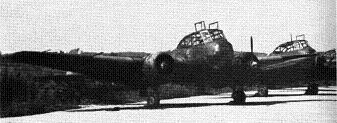![]() The Pacific War Online Encyclopedia
The Pacific War Online Encyclopedia
|
| Previous: Q Class, British Destroyers | Table of Contents | Next: QC Sonar |

U.S. Air Force. Via Francillon (1979)
Kyushu Q1W Tokai ("Eastern Sea") "Lorna"
|
Crew |
3 or 4 |
|
Dimensions |
52'6" by 39'8" by 13'6" 16.0m by 12.1m by 4.1m |
| Wing area | 411 square feet 38 square meters |
|
Weight |
6,839-11,724 lbs 3102-5318 kg |
| Maximum speed | 200 mph at 4395
feet 322 km/h at 1340 meters |
|
Cruise speed |
150 mph at 3280 feet 241 km/h at 1000 meters |
|
Climb rate |
12.5 feet per second 3.8 meters per second |
|
Service ceiling |
14,730 feet 4490 meters |
| Power plant | Two 610 hp (455 kW) Hitachi GK2C Amakaze 31 nine-cylinder radial engines driving three blade variable pitch propellers. |
|
Armament |
One flexible 7.7mm Type 92 machine
gun in the rear cockpit Optional 1 or 2 forward-firing 20mm Type 99 cannon |
|
External stores |
Two 250 kg (551 lb) bombs or depth charges |
| Range | 834 miles 1342 km |
| Sensors |
Type 3 radar Magnetic anomaly detector |
| A total of 153 Q1W at Kyushu Hikoki K.K. from 1943-9 to 1945-8 |
The Q1W Tokai "Lorna" was just about the only dedicated
antisubmarine aircraft produced by any nation during the Second World
War. It was equipped with a rudimentary Type 3 radar
and magnetic anomaly
detector and was configured with dive brakes to allow it to attack as a
dive bomber. The cabin
arrangement resembled the German
Junkers 88 and allowed the crew
to communicate with each other easily. The radar was
poor enough that most searching was done by
eyeball.
Development began in 1942 in response to a Navy
specification for a three-seat antisubmarine aircraft with good
loitering capability. The aircraft was wanted as quickly as possible,
and designer Nojiri Eng had the prototype ready in September 1943.
Production was authorized in the spring of 1944 but only a modest
number could actually be produced. A version with a wooden rear fuselage to reduce aluminum requirements never went
into production.
"Lorna" operated from Japan, Formosa, and China. Though it handled well, the aircraft was very slow and almost defenseless against Allied fighters, and it suffered heavy casualties late in the war attempting to patrol convoy routes that were already within Allied fighter range.
References
The Pacific War Online Encyclopedia © 2007, 2009 by Kent G. Budge. Index